|
Dr. Manisha Goel1 #1Department of Management Studies J C Bose University of Science and Technology, YMCA Faridabad, Haryana, India Email: singla_manisha@rediffmail.com, Mobile No.: 9871881788 |
Dr Rajiv Sindwani2 #2Department of Management Studies J C Bose University of Science and Technology, YMCA Faridabad, Haryana, India Email: rajiv_sindwani@yahoo.co.in, Mobile No.: 9810432422 |
Dr Anushree Chauhan3 6+#3Department of Management Studies J C Bose University of Science and Technology, YMCA Faridabad, Haryana, India Email: anushree27973@gmail.com, Mobile No.: 9971893518 |
Dr Anushree Chauhan3 #4Department of Management Studies J C Bose University of Science and Technology, YMCA Faridabad, Haryana, India Email: bhawnasharma9293@gmail.com, Mobile No.: 9999437103 |
Now a days, Customers are being considered as king of the market for any business. It is important for all the business organizations to meet the expectations of their customers. It has become essential for success of any business to know whether their customers are satisfied or not. Customer Satisfaction is the measure of how the needs and responses are collaborated and delivered to customer expectation. It can only be attained if the customer has an overall good relationship with the company. The present study is focused on comparative analysis of level of customer satisfaction in FMCG sector. For the purpose of the study various factors affecting customer satisfaction in FMCG sector has been analysed in detail.
Keywords: Customers, Customer expectation, Profit, Status, Satisfaction, Satisfied customer.
1.Introduction FMCG industry has witnessed strong growth in the past decade. This has been due to liberalization, urbanization, increase in the disposable incomes and altered lifestyle. Furthermore, the boom has also been fuelled by the reduction in excise duties, de-reservation from the small-scale sector and the concerted efforts of personal care companies to attract the burgeoning affluent segment in the middle-class through product and packaging innovations. Unlike the perception that the FMCG sector is a producer of luxury items targeted at the elite, in reality, the sector meets the everyday needs of the masses. In India, companies like ITC, HUL, Dabur, Colgate, Cadbury and Nestle have been a dominant force in the FMCG sector well supported by relatively less competition and high entry barriers.
Paul S. Goldner (2006) defines, “…a customer is any organization or individual with which you have done business over the past twelve months”. Grigoroudis, E and Siskos, Y (2009) provide definition for ‘customer’ upon two approaches: With reference to loyalty, “A customer is the person that assesses the quality of the offered products and services” and on process oriented approach, “the customer is the person or group that receives the work output”. Satisfaction has been broadly defined by Vavra, T.G. (1997) as a satisfactory post-purchase experience with a product or service given an existing purchase expectation. Howard and Sheth (1969) define satisfaction as, “The buyer’s cognitive state of being adequately or inadequately rewarded for the sacrifices he has undergone.” According to Westbrook and Reilly (1983), customer satisfaction is “an emotional response to the experiences provided by, associated with particular products or services purchased, retail outlets, or even molar patterns of behaviour such as shopping and buyer behaviour, as well as the overall market place”. Oliver (1981) put forward a definition as, “the summary psychological state resulting when the emotion surrounding disconfirmed expectations is coupled with the consumers’ prior feelings about the consumption experience” Tse and Wilton (1988) define as, “the consumer’s response to the evaluation of the perceived discrepancy between prior expectations (or some other norm of performance) and the actual performance of the product/service as perceived after its consumption” Berry and Parasuraman (1991) argue that since customers’ satisfaction is influenced by the availability of customer services, the provision of quality customer service has become a major concern of all businesses. Customer satisfaction is typically defined as a post consumption evaluative judgement concerning a specific product or service. It is the result of an evaluative process that contrasts pre-purchase expectations with perceptions of performance during and after the consumption experience. Oliver (1981) defines customer satisfaction as a customer’s emotional response to the use of a product or service. Anton (1996) offers more elaboration: “customer satisfaction as a state of mind in which the customer’s needs, wants and expectations throughout the product or service life have been met or exceeded, resulting in subsequent repurchase and loyalty”. Merchant Account Glossary points out that, “Customer satisfaction is an ambiguous and abstract concept and the actual manifestation of the state of satisfaction will very from person to person and produce/service to produce/service.” Schiffman and Kanuk (2004) defines customer satisfaction as “The individual’s perception of the performance of the product or service in relation to his or her expectations”.
Exploratory research has been carried out to find out the level of customer satisfaction in FMCG sector in India
1) To find out the various factors affecting customer satisfaction in FMCG sector.
2) To examine the variations in level of customer satisfaction on different demographic variables in FMCG sector.
3) To examine the variations in level of customer satisfaction of different companies in FMCG sector.
To conduct this research following hypothesis are formulated: H1: There is no significant difference between levels of customer satisfaction of customers of different age group in FMCG sector. H2: There is no significant difference between levels of customer satisfaction of customers of different gender group in FMCG sector. H3: There is no significant difference between levels of customer satisfaction of customers of different income group in FMCG sector. H4: There is no significant difference between level of customer satisfaction of customers of different companies in FMCG sector.
The survey has been conducted in Delhi NCR. The period of study is two years. The present study is based on survey of the customers of five major players in FMCG sector in India i.e. like ITC, HUL, Dabur, Patanjali and Nestle. For the purpose of the study both primary and secondary data has been used. The secondary data has been collected through journals, magazines, and other published research papers. The primary data has been collected with the help of structured questionnaire. The questionnaire is based on 5 point Likert scale where 1 means Strongly Agree, 2 means Agree, 3 means Neutral, 4 means Disagree and 5 means Strongly Disagree.
Questionnaires have been filled by the customers of above the selected companies in FMCG sector. The size of sample is taken as 400 customers. The sampling technique used for the purpose of sample selection is non-probability sampling i.e. convenience sampling. A total of 400 questionnaires have been distributed out of which 350 questionnaires have been collected and are used to conduct the analysis
For the purpose of data analysis, statistical techniques such as Exploratory Factor Analysis, Reliability Testing and ANOVA have been applied. The analysis has been carried out with the help of SPSS software
The analysis results pointed out that the sample represented the entire population as survey captured responses from people from various age groups, gender, and income group. To get an overview of sample characteristics, an analysis of the demographic characteristics of 350 respondents was carried out. With the help of simple descriptive statistics the respondents’ characteristics were summarized. Table 1.1 presents the profile of the respondents.
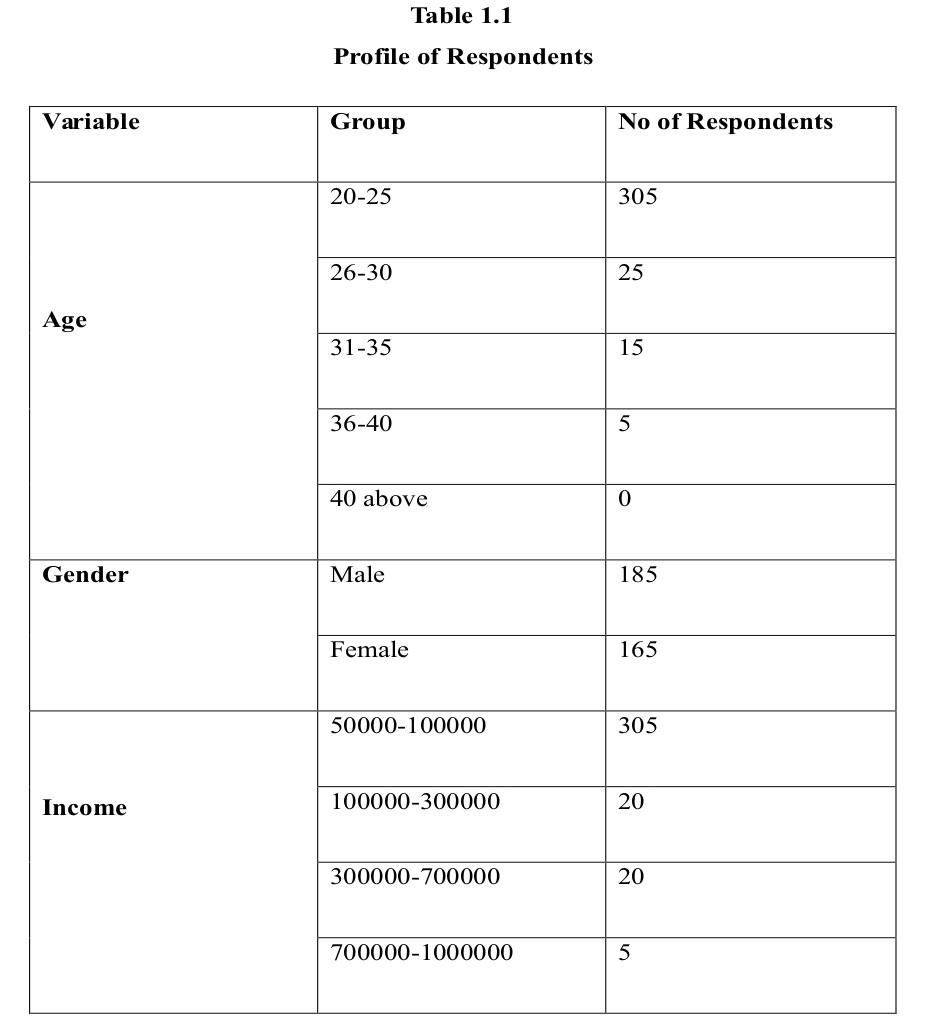
The 20 items related to Customer Satisfaction in FMCG Sector as shown in table 1.2 has been used for the purpose of study. Exploratory factor analysis has been applied to identify the factors of customer satisfaction in FMCG Sector to the captured responses from 350 respondents corresponding to 20 items
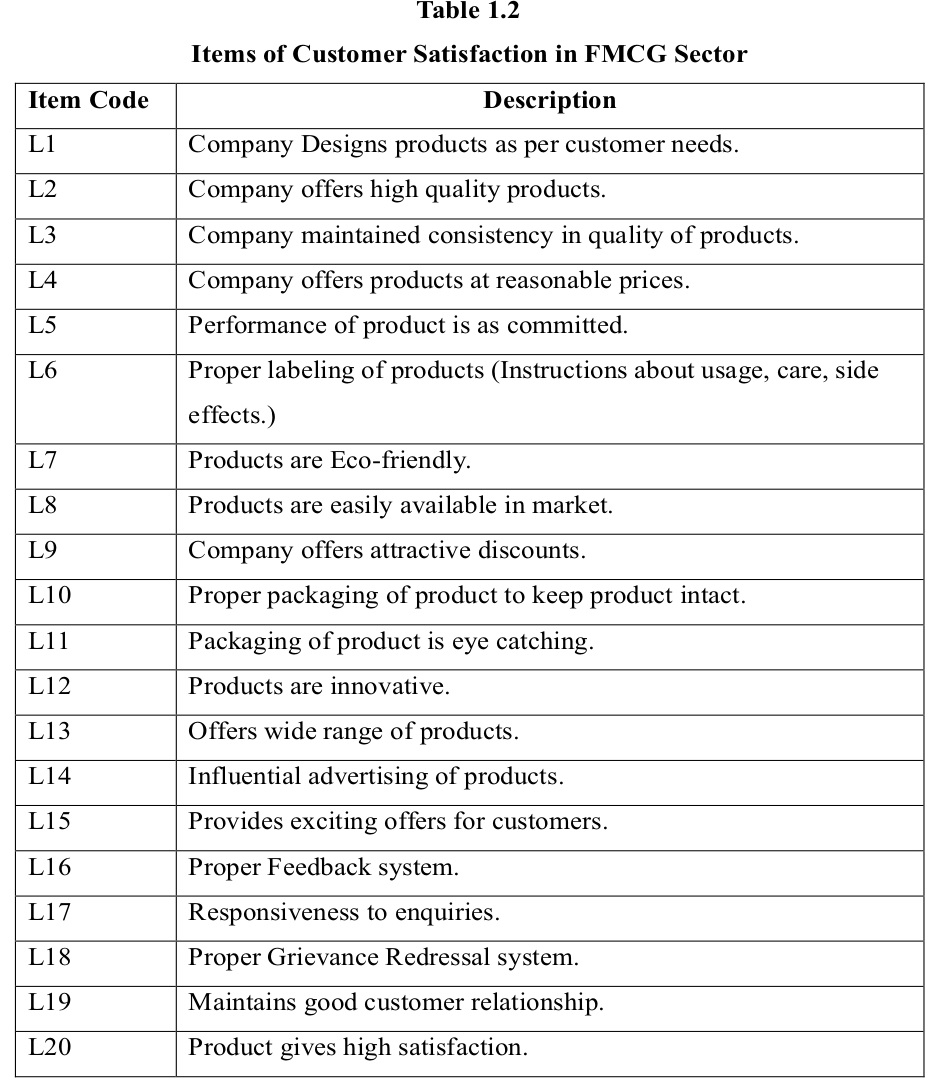
Factors were extracted under the restriction that the Eigen value of each generated factor was more than one (Malhotra and Birks, 2007). Only variables with loadings of at least 0.4 (Hair et al., 2010) were considered in the analysis. The study of 20 variables yielded four factors. The extracted factors were then rotated using Varimax rotation method, which is a most widespread method of factor rotation (Kinnear and Gray, 2010). These rotated factors with their variable constituents and factor loadings are given in table 1.3.
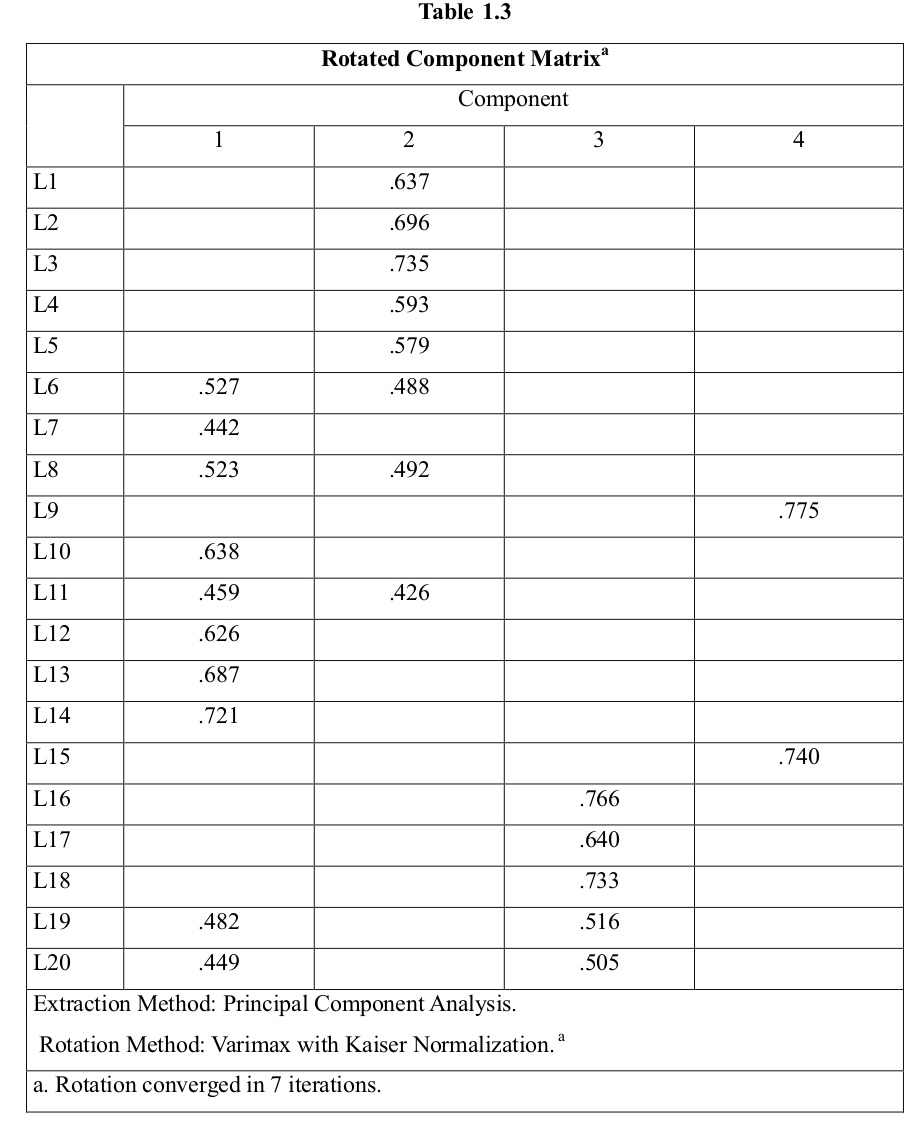
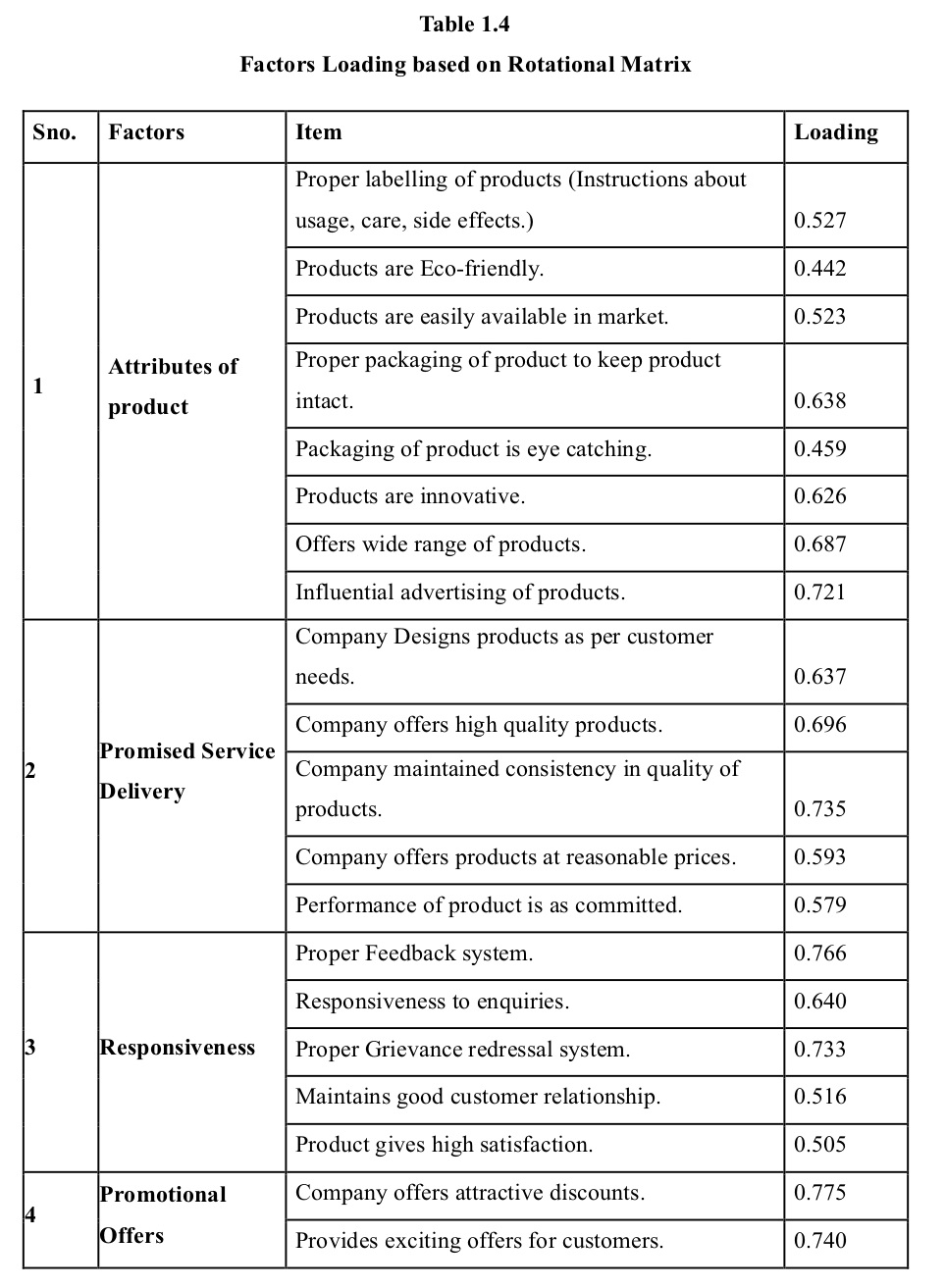
Taking into consideration variables loaded on different factors and relevant literature, four factors are named as Attributes of product; Promised Service Delivery; Responsiveness; Promotional offers.
|Total eight items loaded on this factor, which was a maximum number of items on any factor in this study. The factor included following items: Proper labelling of products (Instructions about usage, care, side effects.), Products are Eco-friendly, Products are easily available in market, Proper packaging of product to keep product intact, Packaging of product is eye catching, Products are innovative, Offers wide range of products, Influential advertising of products.
Total five items loaded on this factor. The factor included following items: Company Designs products as per customer needs, Company offers high quality products, Company maintained consistency in quality of products, Company offers products at reasonable prices, Performance of product is as committed.
: Total five items loaded on this factor. The factor included following items: Proper Feedback system, Responsiveness to enquiries, Proper Grievance redressal system, Maintains good customer relationship, Product gives high satisfaction.
Total two items loaded on this factor. The factor included following items: Company offers attractive discounts, Provides exciting offers for customers.
To examine the variations in level of customer satisfaction on different demographic variables in FMCG sector various hypotheses are formulated:
There is no significant difference between level of customer satisfaction of customers of different age group in FMCG sector.
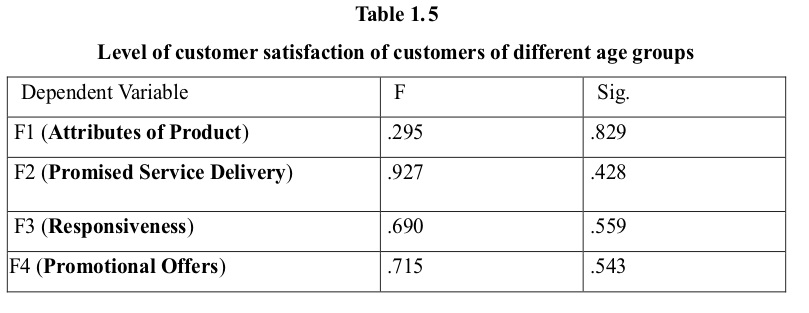
As per the table 1.5, the results indicate that the p value for Attributes of Product, Promised Service Delivery, Responsiveness, Promotional Offers are higher than 0.05. It indicates that there is no significance difference in level of customer satisfaction of customers of different age group in FMCG sector. So, the hypothesis that there is no significant difference between level of customer satisfaction of customers of different age group in FMCG sector is accepted.
There is no significant difference between level of customer satisfaction of customers of different gender group in FMCG sector.
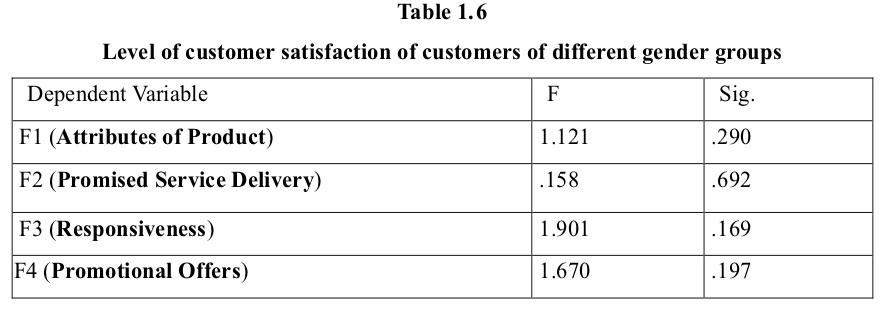
As per the table 1.6, the results indicate that the p value for Attributes of Product, Promised Service Delivery, Responsiveness, Promotional Offers are higher than 0.05. It indicates that there is no significance difference in level of customer satisfaction of customers of different gender group in FMCG sector. So, the hypothesis that there is no significant difference between levels of customer satisfaction of customers of different gender group in FMCG sector is accepted.
There is no significant difference between levels of customer satisfaction of customers of different income group in FMCG sector.
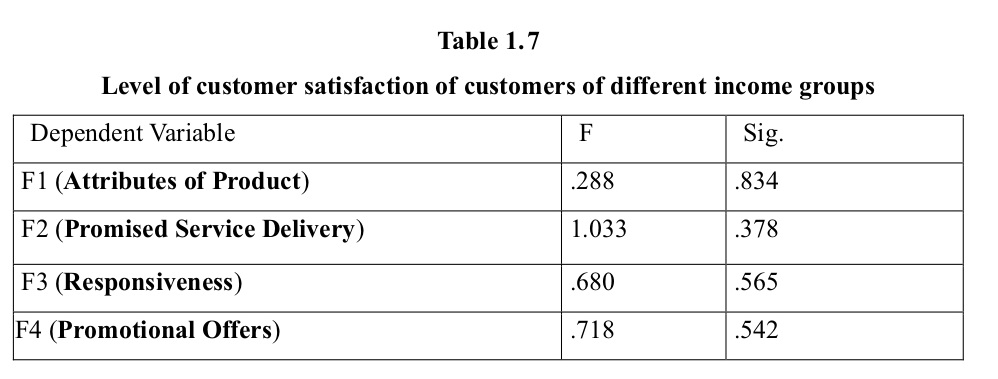
As per the table 1.7, the results indicate that the p value for Attributes of Product, Promised Service Delivery, Responsiveness, Promotional Offers are higher than 0.05. It indicates that there is no significance difference in level of customer satisfaction of customers of different income group in FMCG sector. So, the hypothesis that there is no significant difference between level of customer satisfaction of customers of different income group in FMCG sector is accepted.
To examine the variations in level of customer satisfaction of customers of different companies in FMCG sector the following hypotheses has been formulated: H4: There is no significant difference between level of customer satisfaction of customers of different companies in FMCG sector.
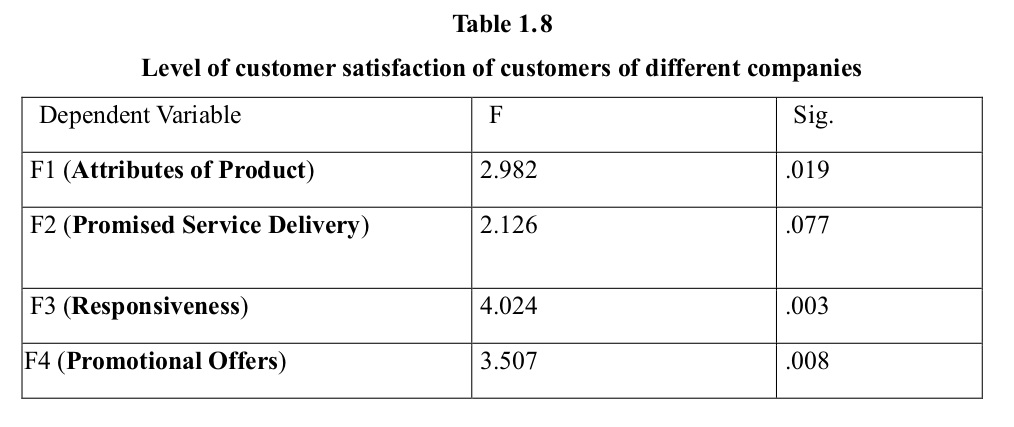
As per the table 1.8, the results indicate that the p value for Promised Service Delivery, Promotional Offers are higher than 0.05. It indicates that there is no significance difference in level of customer satisfaction of customers of different companies in FMCG sector on the basis of Promised Service Delivery and Promotional Offers. So, the hypothesis that there is no significant difference between levels of customer satisfaction of customers of different companies in FMCG sector on the basis of Promised Service Delivery and Promotional Offer is accepted. As per the table 1.8, the results indicate that the p value for Attributes of Product, Promotional Offers is less than 0.05. It indicates that there is significance difference in level of customer satisfaction of customers of different companies in FMCG sector on the basis of Attributes of Product and Promotional Offers. So, the hypothesis that there is no significant difference between level of customer satisfaction of customers of different companies in FMCG sector on the basis of Attributes of Product and Promotional Offers is rejected.
On the basis of the results of the study it can be concluded that from the point of view of customers, the quality of the products provided by ITC is comparatively is very high whereas the quality of products provided by nestle is lowest as compared to the quality of products of other brands. Performance of product of ITC is comparatively highest whereas that of Dabur is comparatively the lowest as compared to products of other brands. As per the results of the study, ITC provides the high range of products whereas Nestle provide less range of products as compared to other brands. The state of satisfaction depends on a number of both psychological and physical variables which correlate with satisfaction behaviours such as return and recommend rate. The level of satisfaction can also vary depending on other factors the customer, such as other products against which the customer can compare the organization's products. To avoid difficulties stemming from the kaleidoscope of customer expectations and differences, some experts urge companies to “concentrate on a goal that’s more closely linked to customer equity. Organizations need to retain existing customers while targeting non-customers.
Anderson, E.W., C. Fornell & S.K. Mazvancheryl (2004)..Customer Satisfaction and Shareholder Value. Journal of Marketing. Vol. 68. October. 172-185. Batra, R. and Olli T. Athola (1990).Measuring the Hedonic and Utilitarian Sources of Consumer Attitudes. Marketing Letters. 2 (2). 159-70. Berry, Leonard L.; A. Parasuraman (1991). Marketing Services: Competing Through Quality. New York: Free Press. ISBN 978-0-02-903079-0. Drolet, Aimee L., and Donald G. Morrison.Do we really need multiple-item measures in service research? Journal of service research 3. no. 3 (2001): 196-204. Eroglu, Sergin A. and Karen A. Machleit (1990).An Empirical Study of Retail Crowding: Antecedents and Consequences. Journal of Retailing. 66 (Summer). 201-21. Farris, Paul W., Neil T. Bendle, Phillip E. Pfeifer, David J. Reibstein (2010). Marketing Metrics: The Definitive Guide to Measuring Marketing Performance. Upper Saddle Rive. New Jersey: Pearson Education. Fornell, C., R.T. Rust and M.G. Dekimpe (2010) .The Effect of Customer Satisfaction on Consumer Spending Growth. Journal of Marketing Research. 47(1). 28-35. Fornell, C., S. Mithas, F.V. Morgeson III, and M.S. Krishnan (2006).Customer Satisfaction and Stock Prices: High Returns, Low Risk. Journal of Marketing. 70(1). 3−14. Gitman, Lawrence J.; Carl D. McDaniel (2005). The Future of Business: The Essentials. Mason. Ohio: South-Western. Homburg, Christian, Nicole Koschate, and Wayne D. Hoyer..The role of cognition and affect in the formation of customer satisfaction: a dynamic perspective. Journal of Marketing 70.3 (2006): 21-31. John, Joby (2003). Fundamentals of Customer-Focused Management: Competing Through Service. Westport, Conn.: Praeger. ISBN 978-1-56720-564-0. Johnson, Michael D., Andreas Herrmann, and Frank Huber.The evolution of loyalty intentions. Journal of marketing 70.2 (2006): 122-132. Kessler, Sheila (2003).Customer satisfaction toolkit for ISO 9001:2000. Milwaukee, Wis.: ASQ Quality Press. ISBN 0-87389-559-2. Kucukosmanoglu, Ahmet Nuri; Sensoy Ertan (2010).Customer Satisfaction: A Central Phenomenon in Marketing. Morgeson, F. V., & Petrescu, C. (2011). Do They All Perform Alike? An Examination of Perceived Performance, Citizen Satisfaction and Trust with US Federal Agencies. International Review of Administrative Sciences. 77(3). 451-479. Salant, Priscilla, and Don A. Dillman(1995).How to Conduct your own Survey: Leading professional give you proven techniques for getting reliable results. Turel, Ofir; Alexander Serenko (2006) .Satisfaction with mobile services in Canada: An empirical investigation. Telecommunications Policy. 30 (5-6): 314–331. Westbrook, Robert A. (1980).A Rating Scale for Measuring Product/Service Satisfaction. Journal of Marketing. 44 (Fall). 68-72. Westbrook, Robert A., and Richard L. Oliver.The dimensionality of consumption emotion patterns and consumer satisfaction.. Journal of consumer research (1991): 84-91. Willis, R.; Serenko, A.; Turel, O. (2007). Contractual Obligations between Mobile Service Providers and Users. IGI Global. pp. 143–148. Wirtz, Jochen and John E. G. Bateson (1995).An Experimental Investigation of Halo Effects in Satisfaction Measures of Service Attributes. International Journal of Service Industry Management. 6 (3). 84-102. Wirtz, Jochen; Chung Lee, Meng (2003).An Empirical Study on The Quality and Context-specific Applicability of Commonly Used Customer Satisfaction Measures. Journal of Service Research. Vol. 5. No. 4. 345-355.